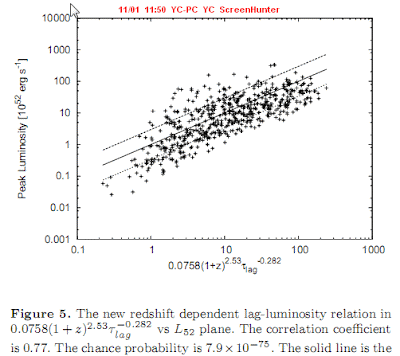主要内容:
NOT the reverse shock of GRB jet, but the wind from WR-star. This wind will react with ISM and reverse shock can give a rise in the GRB afterglow.
This paper is a clue for the environment of long GRBs. 考虑暴周环境的时候可以从这篇文章开始。
精彩摘抄:
文章信息:
| Title: |
| The Signature of a Wind Reverse Shock in Gamma-Ray Burst Afterglows |
| Authors: |
| Pe'er, Asaf; Wijers, Ralph A. M. J. |
| Affiliation: |
| AA(Astronomical Institute ``Anton Pannekoek'', Kruislaan 403, 1098SJ Amsterdam, Netherlands; apeer@science.uva.nl.), AB(Astronomical Institute ``Anton Pannekoek'', Kruislaan 403, 1098SJ Amsterdam, Netherlands; apeer@science.uva.nl.) |
| Publication: |
| The Astrophysical Journal, Volume 643, Issue 2, pp. 1036-1046. (ApJ Homepage) |
| Publication Date: |
| 06/2006 |
| Origin: |
| UCP |
| ApJ Keywords: |
| Gamma Rays: Bursts, Gamma Rays: Theory, Plasmas, Radiation Mechanisms: Nonthermal, Shock Waves |
| Abstract Copyright: |
| (c) 2006: The American Astronomical Society |
| DOI: |
| 10.1086/500969 |
| Bibliographic Code: |
| 2006ApJ...643.1036P |
Abstract
Explosions of massive stars are believed to be the source of a significant fraction of gamma-ray bursts (GRBs). If this is indeed the case, then the explosion blast wave propagates into a complex density structure, composed of a stellar wind bounded by two shock waves-a wind reverse shock and a forward shock. As the explosion blast wave reaches R
0, the radius of the wind reverse shock, it splits into two shock waves-a reverse and a forward shock wave. We show that the reverse shock thus produced is not strong; therefore, full analytical treatment is required in calculating its properties. We calculate the dynamics of the flow and the evolution of the blast waves in all of the different stages. We show that the fluid Lorentz factor at r>R
0 is equal to 0.725 times the blast wave Lorentz factor as it reaches R
0 and is time (and r) independent as long as the blast wave reverse shock exists. Following the calculation of the blast wave evolution, we calculate the radiation expected in different energy bands. We show that about a day after the main explosion, as the blast wave reaches R
0, the observed afterglow flux starts to rise. It rises by a factor of about 2 in a few hours, during which the blast wave reverse shock exists, and then declines. We show that the power-law index describing the light-curve time evolution is different at early (before the rise) and late times and is frequency dependent. We present light curves in the different energy bands for this scenario.
 Solid: mass density; dashed: energy density
Solid: mass density; dashed: energy density




